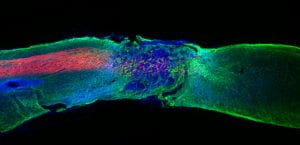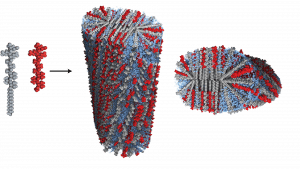Research in the Stupp Group
Research in the Stupp group integrates chemistry with materials science, biology, and medicine. The overarching interest of the group is the development of self-assembling organic materials, focusing on functions relevant to energy and medicine. In the area of energy science, the laboratory’s interests include materials for solar photovoltaics, catalytic materials that can synthesize solar fuels, supramolecular ferroelectrics for non-volatile memories, and artificial muscle materials for inter-conversion of chemical and mechanical energy. In the area of medicine, the Stupp laboratory focuses on biomaterials for regenerative medicine of the brain, spinal cord, bone, cartilage and muscle, and also on targeted systemic drug delivery using nanostructures for cancer and cardiovascular applications. The organic structures of interest in both areas include visible-light-absorbing chromophores, organometallic catalysts, electron donors and acceptors, DNA, peptides, glycopeptides, and polymers, among others. The group is organized into three subgroups that meet weekly to discuss progress: Energy Materials, Biomaterials, and Supramolecular Self-Assembly. Research activities include molecular synthesis and characterization of structure with a broad suite of microscopies and synchrotron X-ray scattering, measurement of materials properties, computer simulations, construction of solar cells and other electronic devices, molecular and cell biology, and in vivo studies of the efficacy of materials and nanostructures in biomedical applications.
Energy Materials
The energy materials subgroup is currently focused on materials for solar photovoltaic devices and hydrogels that can harvest light and use catalysts in their three-dimensional structure to generate solar fuels such as hydrogen or to reduce carbon dioxide. An important area of interest in this subgroup involves hybrid organic-inorganic materials for energy applications, including supercapacitors and dye-sensitized solar cells.
Biomaterials
 The biomaterials subgroup focuses on the development of bioactive materials that can directly signal cells for regenerative medicine. The chemical systems include self-assembling peptide amphiphiles, DNA nanotechnology, and biopolymers to design solid scaffolds or injectable nanostructures to create bioactive artificial extracellular matrices. The targets include spinal cord regeneration to avoid paralysis, treatments for Parkinson’s disease, regeneration in the heart after infarction, and strategies to regenerate muscle, bone, and cartilage, among other tissues. Other work in this subgroup focuses on nanostructures for use in systemic targeted therapies.
The biomaterials subgroup focuses on the development of bioactive materials that can directly signal cells for regenerative medicine. The chemical systems include self-assembling peptide amphiphiles, DNA nanotechnology, and biopolymers to design solid scaffolds or injectable nanostructures to create bioactive artificial extracellular matrices. The targets include spinal cord regeneration to avoid paralysis, treatments for Parkinson’s disease, regeneration in the heart after infarction, and strategies to regenerate muscle, bone, and cartilage, among other tissues. Other work in this subgroup focuses on nanostructures for use in systemic targeted therapies.
Supramolecular Self-Assembly
 Group members in the supramolecular self-assembly subgroup focus on fundamental supramolecular chemistry and materials science aimed at learning how to program molecules to assemble into functional materials. The systems studied cover the broad range of molecular structures and functions of interest to the Stupp laboratory.
Group members in the supramolecular self-assembly subgroup focus on fundamental supramolecular chemistry and materials science aimed at learning how to program molecules to assemble into functional materials. The systems studied cover the broad range of molecular structures and functions of interest to the Stupp laboratory.
